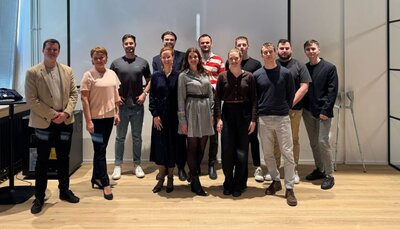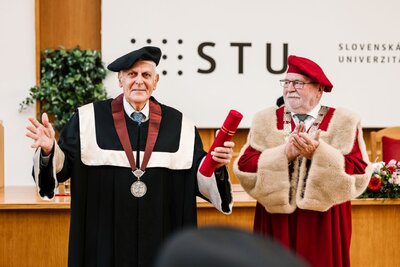
Faculty of Chemical and Food Technology
Department/Institute: Institute of Organic Chemistry, Catalysis and Petrochemistry
Contact person: prof. Dr. Viktor Milata, DSc., Dr. Daniel Végh, DSc.
Contact: +421 2 5932 5148
e-mail: viktor.milata@stuba.sk, daniel.vegh@stuba.sk
web page: http://www.chtf.stuba.sk/koch/indexe.php
Description:
The three laboratories of the research group (No. 402, 404 and 410) see the syntheses of heterocyclic compounds done, by both classic and non-classic procedures (chemical, photochemical and electrochemical approaches, even those using ultrasound and microwaves), as well by methods of green chemistry, supported by the existing infrastructure: ATR FT IR and UV for ascertaining structure of intermediates, obtained by solid-support syntheses, a microwave reactor C3EM for organic synthesis, equipped with power control, controlled pressure, temperature and time measurement.
The generated special oligomers are small molecules with pronounced opto-electronic properties, which play an important role in building novel attractive materials sans defect polymers and preparation of strictly defined optoelectronic devices at molecular level. Designing molecules with electronic defects, removal of selected substituents or terminal groups, required for blocking or releasing functional groups required devices at molecular level, or possess other specific utility functions such as hydrophilic, hydrophobic, electron-donating and electron-withdrawing.
Synthesis of small molecules, based on activated enolethers, with potential bioactivity; pyrazoles, isoxazoles, pyrimidines, quinolines and quinolones stripped of substituents, substituted or with fused rings, serving for UV photoactivation or anticancerogenic activity. Preparation of analogs and models of known quinolone type drugs carrying fluorines, nitro group, selenadiazole skeleton a etc.
Projects and cooperation:
- Centre for industrial research of optimal process of the synthesis of highly effictive drugs (ITMS 26240220061),
- Centre of excelency of the method and processes of green chemistry (ITMS 26240120001), Finalisation of the Centre of excelency of the method and processes of green chemistry (CEGreen II, 26240120021)
- Centre of excelency of safety research (2620002 OPVaV-2009/4.1/03-SORO)
Grants from Slovak Research and Development Agency:
- 2008-10: Spectroscopic analysis of natural and synthetic quinoline derivatives with photochemical and photobiological properties;
- 2008-10: Research into preparation of diphenylamine derivatives as stabilizers of polymers and oils, and procedures for reaching of their higher effectiveness;
- 2011-2014: Photoinduced processes of natural and synthetical heterocyclic compounds with biological impact;
- 2012-15: Polyaplicable heterocycles – design, synthesis and properties.
Grants from Slovak Scientific Grant Agency:
- 2008-10: Preparation, biological a physico-chemical properties of new heterocyclic compounds with potential exploitation in medicine, nanotechnologies, wood and paper protection and other applications;
- 2011-13: Preparation and properties of novel fluorous heterocycles with broad field of prospective applications;
- 2014-2016: Partially fluorinated π-conjugated heterocycles - study of their preparations, reactivity and properties)
Selected publications:
1. Arion V. B, Platzer S., Rapta P., Machata P., Breza M., Vegh D., Dunsch L., Telser J., Shova S., Mac Leod T.C.O.: Inorganic Chemistry 52(13), 7524-7540 (2013).
2. Danko M., Andicsova A., Hrdlovic P., Racko D., Vegh D.: Photochemical & Photobiological Sciences 12(7), 1210-1219 (2013).
3. Lukes V., Hrablay I., Solc R., Vegh D., Hrdlovic P., Laurinc V.: Synthetic Metals 159(7-8), 604-612 (2009).
4. Pazitny A., Solcan T., Vegh D. : Journal of Fluorine Chemistry 130(3), 267-294 (2009).
5. Puterova, Zita, Bobula, Tomas, Vegh, Daniel Journal of Heterocyclic Chemistry (2008), 45(1), 201-207.
6. Puterova Z., Andicsova A., Vegh D.: Tetrahedron 64(49), 11262-11269 (2008).
7. Milata V.: Arsoles, Stiboles, and Bismoles. In Comprehensive Heterocyclic Chemistry III, Katritzky A.R., Ramsden C.A., Scriven E.F.V. and Taylor R.J.K., Eds.; Elsevier, Oxford, 2008; Vol. 3, pp 1149 – 1180.
8. Milata V., Rádl S., Voltrová S.: 32.5.3. Product Subclass: Enol Ethers (acyclic, cyclic, i.e. endocyclic C=C-O- unit). Science of Synthesis, Georg Thieme Verlag, Stuttgart 2008, pp. 589-756.
9. Milata V., Segľa P., Brezová V., Gatial A., Kováčik V., Miglierini M., Stankovský Š., Šíma J.: Aplikovaná molekulová spektroskopia, STU Bratislava, 600s., 2008.
10. Bella M., Milata V.: New syntheses of 5,6- and 7,8-diaminoquinolines, Beil. J. Org. Chem. 9, 2669-2674 (2013).
11. Bella M., Milata V., Larina L.: 2-amino-X-nitrobenzimidazoles as precursors of food-borne carcinogens: A new approach to IQ synthesis. J. Heterocycl. Chem. 49(2), 293-296 (2012). DOI: 10.1002/jhet.786.
Photos:

ATR FT IR spectrometer with computer control

Microwave reactor CEM for organic synthesis

UV spectrometer Shimadzu and device for controlled crystallisation under inert atmosphere



